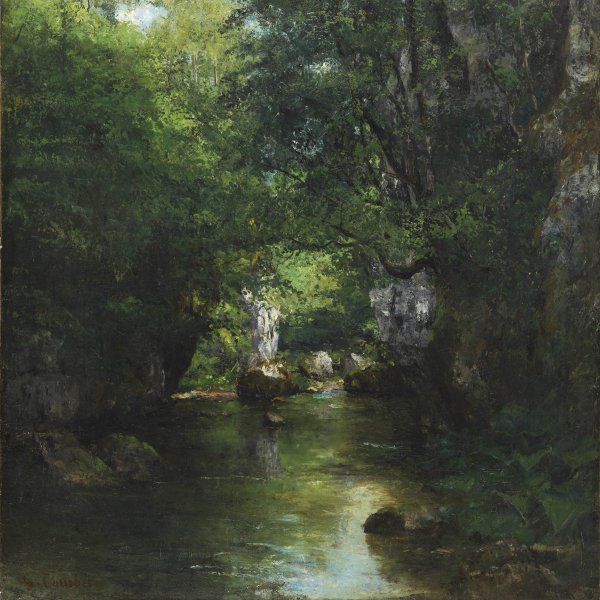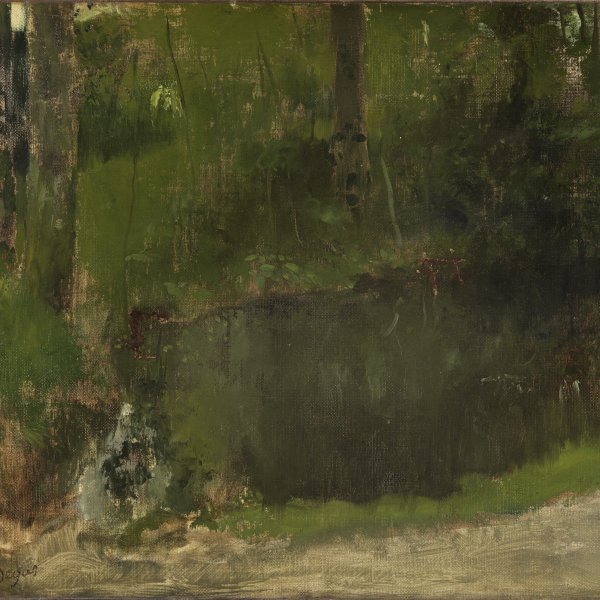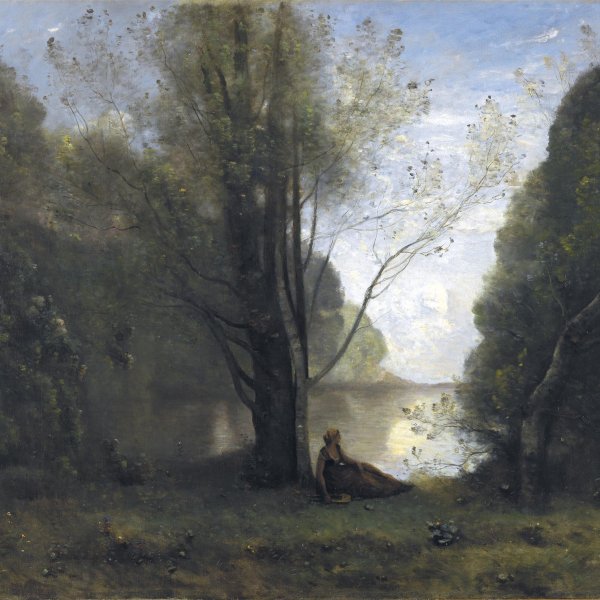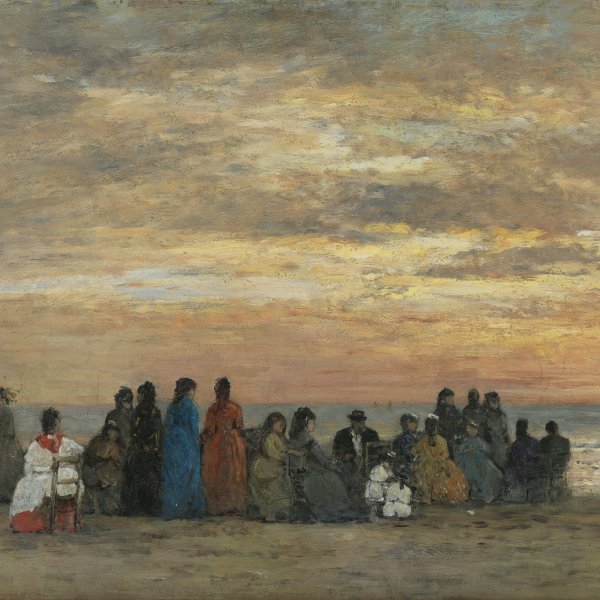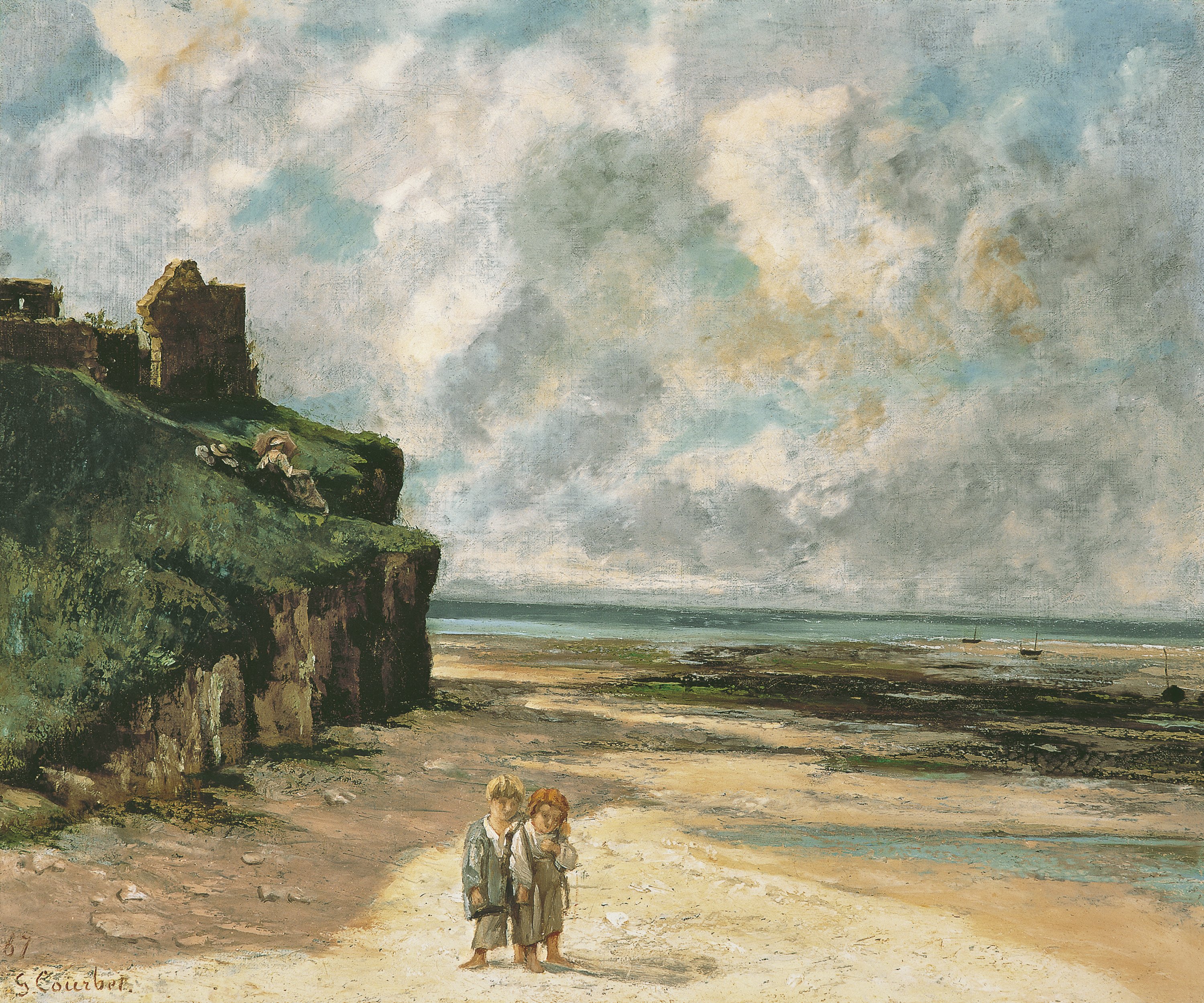The Fisherman's Children
The special appeal of this rather small canvas is threefold: It combines a calm beach at low tide with an extremely varied cloudy sky, a steep shore with one or two resting people, and it finally presents two, obviously poor children in the foreground, forming the only living beings on the beach, and clearly waiting for a response to come from the painter or beholder. The latter's imaginary position may be thought in front of the children, but at the level of the lady on the cliffs, that is, higher than the horizon line. The painter beholder is therefore constituting himself as embracing the entire scene, imbued with a world wide look and, at the same time, watching over every detail.
To begin with the picture's most strange feature, the bare feeted and raggedly clothed children seem to ask for alms, the red-haired girl is even raising one hand to her breast as if in an attitude of veneration. The begging, innocent attitude of the children brings the picture close to Courbet's so-called socialist pictures of which he was speaking in 1868. One should not take this term too literally: What the painter wanted to do was to draw the attention of the bourgeois clientèle of his beach pictures to the abandoned strata of the lower population. A picture of a similar issue is The Charity of a Beggar at Ornans, which was done only one year later than the present picture. At this period of his career, Courbet came back to his earlier predilection for un-idealised characters whom he would depict both to deal with his feeling of justice and to provoke the well-educated visitors to the Paris Salon exhibitions who were frightened to be confronted with lower class people, unless done in a pretty and convenient way. Recently, one has learnt that Courbet visited Madrid in 1868 to refresh his experience of the "people" and that of plain genre painting, but this trip was only to fulfil what he had in mind long ago, and the idea of depicting beggars or gypsies seems even go back to the 1850.
It is completely unusual to combine social issues and landscape painting. Courbet, however, wanted to emphasise, not unlike his former friend, the philosopher Pierre-Joseph Proudhon (dead in 1865), that politics has to face everyday life. He therefore wished to make genre painting and history painting one and the same; this was at the core of his aesthetic demands from the 1848 Revolution on. His picture The Homecoming of c. 1852 (Private Collection) is an early example for that matter. Yet, even in Courbet's work a seascape with a social impact is an exciting exception. Every day life in turn became more and more familiar to him. While he spent sojourns at fashionable Norman seasides two years earlier, in 1867 he followed the invitation of the Parisian chemist, Fourquet, to the small village of Saint-Aubin (Calvados) with its unpretentious beach. He showed his sister Zélie there and wrote to his two other sisters about the place: "Le pays n'est pas très beau. Comme plage ce n'est pas très extraordinaire... c'est très simple. Il n'y a pas d'arbres comme à Trouville et Deauville." It was easy to meet lower class people there. Nevertheless, after the Paris Commune (to which Courbet actively participated) this very picture was used by his friend Jean Bruno for political reasons.
On the other hand, we are far away, in the late 1860s, from the audacity of the Stonebreakers (formerly Dresden, Galerie Neue Meister) or from the frightening black crowd of the Burial (Paris, Musée d'Orsay) of 1850. We are rather meeting with a kind of late Romanticism, in keeping with the soft afternoon sun that covers most of the beach. There is no accusation nor any sign of a social conflict; the painter just sheds a mild light on the unfortunate ragged waifs. Furthermore, he gives them some emphasis by the light-brown, almost white triangle shape of the ground they are standing on. By contrast, this surface is bordered by shadows coming from the dark cliffs at the left (behind which the sun is to be located) and by the blackish areas of the beach on the right. As an effect, a kind of ambiguity reigns all over the composition. In fact, in his seascapes of the 1860s, of which The Fisherman's Children is an outstanding example (similar pictures are at the museums of London, Cologne, Stuttgart), Courbet often alternates wide calm areas with suddenly raising plots of light and shade. Also he insists on heavy materiality whose opaqueness is in contrast with the transparency of other parts; in this case the thick stones in the foreground are played out against the tiny strokes of the sand, the islands of water, the seaweed, the mudbanks and the ever changing clouds. Yet, the transparency also applies to the surface of rocks and meadows. This procedure works as an autonomous factor, independent of the material, and quite different of any Realistic concept. In this respect, The Fisherman's Children is a prelude to the famous Wave pictures of 1869-70, where the painter accomplishes his aim of dissoluting the matter and coherence of his objects. The late Courbet is indeed rather an anti-Realist par excellence. This is the reason why Monet and Cézanne appreciated him so much. Not the object but the stroke and the spot, in other words the self-sufficient play of the colours counted for these painters. Courbet's continuous changing between serenity and gravity also bears a metaphorical meaning; on a psychological level, it shows the constant transfer between the inner life and the world outside. Therefore, the emotional message of the picture is important. Courbet wanted to suggest some empathy for the poor rather than to stimulate a complaint about unequal life conditions or to ask for riots.
The general worldview Courbet is proposing here is that of supremacy of Nature. The children show the grey and brown tones on the beach, the lady resting above the cliffs (with her acquaintance or her belongings arranged in a still-life manner) looks as if immerged into the surrounding green, and the fishermen's boats are almost indistinguishably melted into the dark areas of the beach, as if part of it. From the Studio of the Painter (Paris, Musée d'Orsay) onwards, Courbet would place his emphasis on Nature as the ground out of which human beings come to life. Seascapes played an especially important role within this context for Courbet was a fanatic amateur of any kind of water (such as springs, streams, waves), which symbolised the genesis of life to him. Nature, therefore, was not just a tranquil or impenetrable sphere to him, but rather a lifely area, open to sudden surprises and overwhelming changements. On one hand, Courbet recognised eternal Nature as the only redeeming force, on the other, he depicted its ephemeral effects more than any other painter prior to the Impressionists.
Klaus Herding





